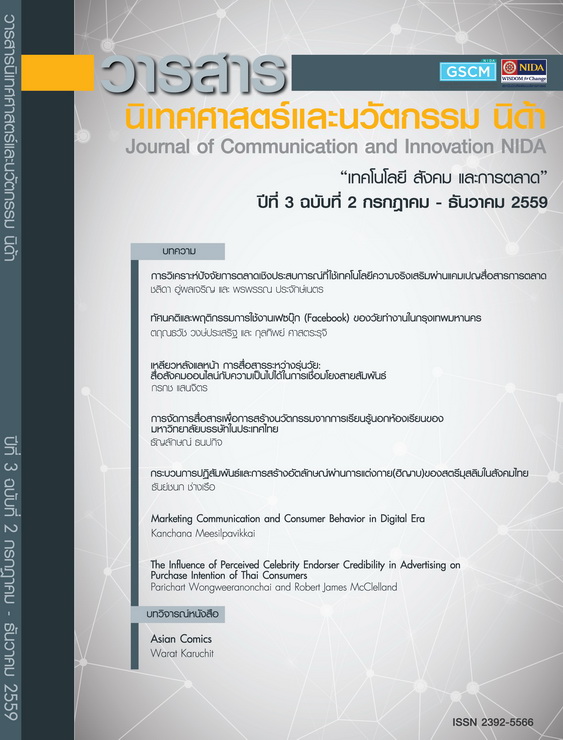การวิเคราะห์ปัจจัยการตลาดเชิงประสบการณ์ที่ใช้เทคโนโลยีความจริงเสริมผ่านแคมเปญสื่อสารการตลาด
Main Article Content
Abstract
การวิจัยครั้งนี้มีวัตถุประสงค์เพื่อวิเคราะห์ปัจจัยการตลาดเชิงประสบการณ์ที่ใช้เทคโนโลยีความจริงเสริมผ่านแคมเปญสื่อสารการตลาดและศึกษาแนวโน้มการใช้เทคโนโลยีความจริงเสริมในการตลาดเชิงประสบการณ์ในอนาคต โดยใช้ระเบียบวิธีวิจัยเชิงคุณภาพ (Qualitative Research) แบ่งออกเป็น 2 วิธีในการเก็บรวบรวมข้อมูล ได้แก่ การวิเคราะห์เนื้อหาเชิงคุณภาพ (Qualitative Content Analysis) โดยศึกษากลุ่มตัวอย่างจากผลงานแคมเปญโฆษณาจากงานเสวนา “Best Ads from Cannes Lions 2015” ที่ผสมผสานเทคโนโลยีความจริงเสริมกับการสื่อสารการตลาด จำนวน 10 แคมเปญ เพื่อใช้ในการวิเคราะห์ปัจจัยส่วนประสมทางการตลาดและปัจจัยการตลาดเชิงประสบการณ์ และการสัมภาษณ์เชิงลึก (In-depth Interview) โดยมีผู้ให้ข้อมูลสำคัญคือ นักการตลาดและโฆษณา นักวิชาการ องค์กรผู้ไม่แสวงหากำไร และบุคคลทั่วไปที่เกี่ยวข้อง ทั้งหมดจำนวน 8 คน ซึ่งเป็นผู้ที่มีความเกี่ยวข้องกับเทคโนโลยีความจริงเสริม (Augmented Reality: AR) ผลการวิจัยมีดังนี้
1. ผลการวิเคราะห์เนื้อหาพบว่า ปัจจัยการตลาดที่ใช้เทคโนโลยีความจริงเสริมผ่านแคมเปญสื่อสารการตลาดมี 2 ปัจจัยสำคัญได้แก่ ปัจจัยส่วนประสมการตลาด และปัจจัยการตลาดเชิงประสบการณ์ โดยการวิเคราะห์ปัจจัยส่วนประสมการตลาดพบว่า แคมเปญการตลาดส่วนใหญ่ใช้สำหรับสินค้าอุปโภคบริโภคและเทคโนโลยี ซึ่งใช้เพื่อการส่งเสริมการตลาดได้แก่ การโฆษณา ประชาสัมพันธ์ และการส่งเสริมการขาย และการวิเคราะห์ปัจจัยการตลาดเชิงประสบการณ์พบว่า เป็นแคมเปญที่มีการรับรู้การตลาดเชิงประสบการณ์จากประสาทสัมผัส (Sense) และการรับรู้การตลาดเชิงประสบการณ์จากความรู้สึก (Feel) มากที่สุด รองลงมาคือ การรับรู้การตลาดเชิงประสบการณ์จากความคิด (Think) การรับรู้การตลาดเชิงประสบการณ์จากการกระทำ (Act) และการรับรู้การตลาดเชิงประสบการณ์จากความเชื่อมโยง (Relate)
2. ผลการสัมภาษณ์เชิงลึกพบว่า แนวโน้มความเป็นไปได้ในอนาคตของเทคโนโลยีความจริงเสริมในการตลาดเชิงประสบการณ์ สามารถแบ่งออกเป็น 4 ประเด็นที่สำคัญ ได้แก่ การใช้งานเทคโนโลยีความจริงเสริมในด้านการสื่อสารการตลาด การพัฒนาและลดข้อจำกัดของเทคโนโลยีความจริงเสริมที่ใช้ในการตลาดเชิงประสบการณ์ การยอมรับเทคโนโลยีความจริงเสริมในด้านการสื่อสารการตลาด และทิศทางความเป็นไปได้ในอนาคตของการใช้เทคโนโลยีความจริงเสริมในด้านการสื่อสารการตลาด
The objectives of this research were to analyze augmented reality experiential marketing through marketing communication campaigns and study trends of implementing augmented reality experiential marketing in experiential marketing in the future. The data compilation for this qualitative research was divided into two main parts. First, qualitative content analysis, the sample group comprised ten advertising campaigns from the “Best Ads from Cannes Lions 2015” combining augmented reality with marketing communication for the purposes of conducting analysis of marketing mix and experiential marketing factors. Second, in-depth interview was semi-structured interviews. The informants consisted of eight marketing and advertisement executives, specialists, non-profit organization, and relevant persons. They involved in the augmented reality (AR).
The findings indicated that:
- The results of contents research showed that the two major factors of
marketing factors which applied augmented reality through marketing campaigns were marketing mix factors and experiential marketing. The analysis on marketing mix factors found that most of marketing campaigns were campaigns for consumer products and technology, including advertisement, public relations and sales promotion, for marketing promotion. Meantime, the analysis on experiential marketing revealed that the campaign was mostly acknowledged by sense and feeling, followed by thought, act and relation, respectively.
- The results of in-depth interviews revealed that the possible trends of
technology arising out of various factors which can be divided into four main issues: application of augmented reality in marketing communication, development augmented reality and reducing its limitation in experiential marketing, acknowledgment of augmented reality in marketing communication, and possible trends of using augmented reality in marketing communication in the future.
Article Details
ข้อความและความเห็นในวารสารนิเทศศาสตร์และนวัตกรรม นิด้า เป็นของผู้เขียนแต่ละท่าน มิใช่ของคณะนิเทศศาสตร์และนวัตกรรมการจัดการ สถาบันบัณฑิตพัฒนบริหารศาสตร์


